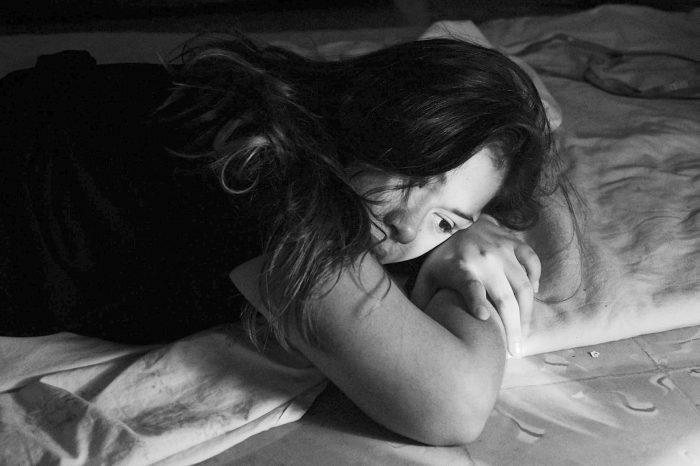I see you: standing there in your closet.
I see you: strapped in a tank top and pulling every sweater you have down from the hanger, standing in different positions next to that dusty full-length mirror.
I see you: rotating between standing with your shoulders pulled back, stomach sucked in, and standing with your hip cocked sideways, shirt ruffled on the bottom.
12 different outfit combinations, three of them tried on twice, all of them heaped on the closet floor—discarded with disgust.
Nothing looks good, and worse than that, nothing feels good. You settle on the same old, broken-in sweater and stretchy jeans. Promising that next week, you’ll skip that extra glass of wine or exercise harder.
I vividly remember the shame I felt when I graduated from size 8 American Eagle bootcut jeans to size 10. I cried in the fitting room that day. I knew I was now on the fast track to getting f-a-t.
It started before this, though.
I was hyperaware that I didn’t look like the other girls on my volleyball team in the locker room: I was not tall. I was not thin. My belly was not slant-board flat; it was pouchy on the bottom and slightly rounded.
My thighs were big, muscular, and bulgy. I always had to size up those tiny spandex shorts to accommodate my thunder thighs, and, still, they rode up. I used deodorant on the inside of my thighs because, even at my six-year span of size 8 jeans, they still rubbed together and chaffed.
On the court, I was aware that parts of my body jiggled when I moved. As a freshman, I hadn’t noticed. I loved playing volleyball; it was the first and only sport I ever had any talent for. The nuances of the game and plays fascinated me. I could focus solely on playing.
By the time I was a senior, it became increasingly difficult to focus on the game and not what I believed others were thinking about me. I was too concerned that other folks were dissecting my jiggly parts, commenting on my spandex creeping into intimate places it shouldn’t go.
Eventually, I quit the sport altogether—with three games left in the season.
For four years, I had dedicated summer mornings and every fall afternoon to this sport. I laughed with teammates. We played strip poker on the back of the bus that took us to away games; in our high-school-girl minds, this was provocative and hilarious. We won games, and we lost them. We celebrated together and cried together.
I loved it all, but I allowed my insecurities and chronically harsh inner critic to take all of the love and the good away from me.
I’ve missed out on so much joy because of my negative body image: Wasted hours lamenting about what I looked like in my bathing suit instead of enjoying the day at the beach. Missed out on irreplaceable memories on my honeymoon because all I could focus on was if my new husband was thinking about how fat and pudgy my tummy looked.
My abdominal muscles have been sore for days—after attending any event where I believed I looked unflattering—from the sheer force of sucking in my belly for hours at a time.
When I look back on the last decade, my memories are mostly of feeling shame about my body in some way.
Society at large does a grave disservice to all bodies with the reinforcement and representation of what a female body is supposed to look like.
I hated those thin women with flat stomachs at the beach. I assumed they hated me, too. I judged others’ fitness levels when I became obsessed with exercise and micromanaging my diet. None of this was limited to my view of other women either.
This perception, and the insecurities that can grow in the cracks of it, put an invisible barrier between humans and our ability to connect with each other: judging first their appearance, then their bodies, leaving little to no room for anything else.
Last year, after the stillbirth of my son, I hit an all-time low. Women who experience this physical trauma often do. Physical complications kept me from my tried-and-true coping mechanism—the gym.
The trauma, the grief, and the world’s reaction to a tragic loss like this combined to create a firestorm of alcohol dependency and cheap, comfort food served at bars in the dark.
In the uphill climb of my battle through this swamp, I found myself sobbing on my closet floor. My well-maintained, 14-year streak of firmly wearing a size 10 had ended. I blamed myself for that, too: Not my two C-section scars. Not the trauma. Not the grief. Not the depression medications. Not the isolation.
I couldn’t celebrate all the miles my body had carried me through over the years. I couldn’t find joy in wearing clothes that I genuinely loved. My hyperawareness about my appearance took over everything, just like it had on the volleyball court and the shore of a Florida beach on my honeymoon all those years ago.
It robbed me of the small slivers of joy I desperately needed in the midst of the most difficult storm I’ve ever had to weather.
I decided that day, on my closet floor, that it was to be no more.
I cut all the tags from my clothes. I got rid of my “dream jeans” that I had only managed to squeeze over my genetically-gifted, muscular thighs once in the last 10 years because of spandex laced through denim.
I made myself write down one thing I loved about my body every day for months.
I started to compliment those thin women who I believed hated me for no reason at all other than my un-thinness.
Bit by bit, I learned to recover my body image.
So, to the woman who may find herself in a similar position, clothes heaped on the closet floor, stomach sucked in, and shoulders pulled back, please don’t waste another second allowing any of this to steal your joy.
Clothes are made to fit your body poorly, based on false ideations of what bodies should look like. Clothes should fit your body, not your body to fit the clothes.
~


 Share on bsky
Share on bsky





Read 1 comment and reply